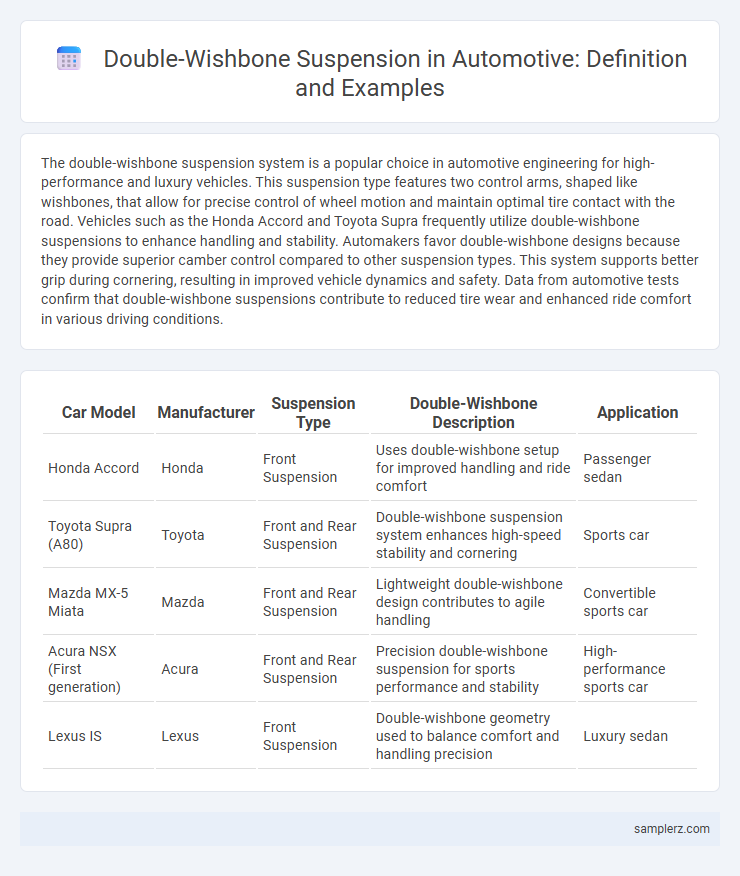The double-wishbone suspension system is a popular choice in automotive engineering for high-performance and luxury vehicles. This suspension type features two control arms, shaped like wishbones, that allow for precise control of wheel motion and maintain optimal tire contact with the road. Vehicles such as the Honda Accord and Toyota Supra frequently utilize double-wishbone suspensions to enhance handling and stability. Automakers favor double-wishbone designs because they provide superior camber control compared to other suspension types. This system supports better grip during cornering, resulting in improved vehicle dynamics and safety. Data from automotive tests confirm that double-wishbone suspensions contribute to reduced tire wear and enhanced ride comfort in various driving conditions.
Table of Comparison
| Car Model | Manufacturer | Suspension Type | Double-Wishbone Description | Application |
|---|---|---|---|---|
| Honda Accord | Honda | Front Suspension | Uses double-wishbone setup for improved handling and ride comfort | Passenger sedan |
| Toyota Supra (A80) | Toyota | Front and Rear Suspension | Double-wishbone suspension system enhances high-speed stability and cornering | Sports car |
| Mazda MX-5 Miata | Mazda | Front and Rear Suspension | Lightweight double-wishbone design contributes to agile handling | Convertible sports car |
| Acura NSX (First generation) | Acura | Front and Rear Suspension | Precision double-wishbone suspension for sports performance and stability | High-performance sports car |
| Lexus IS | Lexus | Front Suspension | Double-wishbone geometry used to balance comfort and handling precision | Luxury sedan |
Understanding Double-Wishbone Suspension Systems
Double-wishbone suspension systems use two parallel arms to connect the wheel hub to the chassis, optimizing wheel alignment and improving handling performance in automotive applications. This design enhances camber control during cornering, enabling better tire contact with the road for increased grip and stability. Commonly found in sports cars and luxury vehicles, double-wishbone suspensions balance comfort and precision, contributing to superior ride quality and responsive steering.
Key Components of Double-Wishbone Suspension
The double-wishbone suspension system features upper and lower control arms, often crafted from forged steel or aluminum, that form the "A" or "wishbone" shape, providing precise wheel alignment and improved handling. Key components include ball joints, which connect the control arms to the steering knuckles, and coil springs or torsion bars that absorb shocks while maintaining ride height. Shock absorbers work in tandem with these elements to dampen vibrations, ensuring optimal stability and comfort on varying road conditions.
Advantages of Double-Wishbone Design in Automobiles
Double-wishbone suspension systems provide enhanced control over camber angle, improving tire contact with the road during cornering for superior handling performance. This design offers greater adjustability in alignment settings, allowing for precise tuning of ride height, camber, and caster to optimize vehicle dynamics. The robust structure of double-wishbone suspensions absorbs shocks effectively, resulting in a smoother ride and increased durability in both high-performance sports cars and off-road vehicles.
Iconic Cars Using Double-Wishbone Suspension
The double-wishbone suspension system is prominently featured in iconic vehicles such as the Honda NSX, known for its precise handling and superior road grip. The Chevrolet Corvette C5 also utilizes this setup to enhance stability and cornering performance, making it a favorite among sports car enthusiasts. Lexus ISF sports sedan employs double-wishbone suspension for a balance of comfort and aggressive handling, showcasing the system's versatility across different automotive segments.
Double-Wishbone Implementation in Sports Cars
Double-wishbone suspension systems are commonly implemented in high-performance sports cars such as the Honda S2000 and Lotus Elise to enhance handling precision and cornering stability. This setup allows independent wheel movement with improved camber control during aggressive driving, optimizing tire contact and grip on race tracks. Engineers prioritize double-wishbone designs for sports vehicles to balance ride comfort with superior responsiveness and durability in dynamic conditions.
Double-Wishbone Suspension in Luxury Vehicles
Double-wishbone suspension systems in luxury vehicles, such as the Lexus LS and Mercedes-Benz S-Class, provide exceptional handling and ride comfort by allowing precise control of wheel motion and maintaining optimal tire contact with the road. The configuration uses two control arms to offer superior camber control and reduced body roll, enhancing stability during cornering. This suspension design is favored in high-end automobiles for its ability to deliver a smooth, responsive driving experience without compromising ride quality.
Comparative Analysis: Double-Wishbone vs. MacPherson Strut
The double-wishbone suspension offers superior camber control and better handling performance compared to the MacPherson strut, making it ideal for high-performance and sports cars like the Honda Accord and Toyota Supra. While the MacPherson strut is more cost-effective and space-efficient, often used in compact vehicles such as the Toyota Corolla, it sacrifices some ride comfort and precise wheel alignment under dynamic conditions. Engineers prefer the double-wishbone design for its enhanced stability and improved tire contact patch during cornering, despite increased manufacturing complexity and weight.
Performance Impact of Double-Wishbone Suspension
Double-wishbone suspension systems enhance vehicle handling by maintaining optimal tire contact and precise camber control during cornering, which significantly improves grip and stability. This suspension design reduces body roll and increases responsiveness, benefiting high-performance sports cars and racing vehicles. The ability to independently adjust both upper and lower arms allows engineers to fine-tune suspension geometry for superior ride quality and dynamic performance.
Double-Wishbone in Off-Road and 4x4 Vehicles
Double-wishbone suspension systems in off-road and 4x4 vehicles provide superior wheel articulation and stability on uneven terrain, enhancing traction and ride comfort. This design allows independent movement of each wheel, reducing body roll during sharp turns and improving ground clearance essential for rugged environments. Vehicles like the Jeep Wrangler and Toyota Land Cruiser utilize double-wishbone setups to optimize off-road performance and durability under demanding conditions.
Future Trends in Double-Wishbone Suspension Technology
Future trends in double-wishbone suspension technology emphasize adaptive materials and embedded sensors to enhance ride comfort and handling precision. Integration of smart actuators enables real-time adjustment of suspension geometry, optimizing performance across diverse driving conditions. Advanced computational models and AI-driven control systems further refine double-wishbone dynamics, promoting safety and efficiency in autonomous and electric vehicles.

example of double-wishbone in suspension Infographic
 samplerz.com
samplerz.com